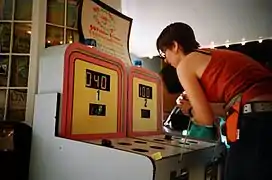Whac-A-Mole
In Japan, モグラ退治 (mogura taiji, "Mole Buster") is a popular arcade game invented in 1975 by Kazuo Yamada of TOGO, based on ten of the designer's pencil sketches from 1974, licensed to Bandai in 1977.[1] It can also be commonly found at Japanese festivals.
 A pair of Whac-A-Mole machines | |
| Manufacturer(s) | Bob’s Space Racers |
|---|---|
| Years active | 1976–present |
Whac-A-Mole is a popular arcade game.
A typical Whac-A-Mole machine consists of a waist-level cabinet with a play area and display screen, and a large, soft, black mallet. Five holes in the play area top are filled with small plastic moles, which pop up at random. Points are scored by whacking each mole as it appears. The faster the reaction the higher the score.
Play
The cabinet has a three-digit readout of the current player's score and, on later models, a best score of the day readout. The mallet is usually attached to the game by a rope in order to prevent anyone from walking away with it.
Current versions of the Whac-A-Mole include three displays for Bonus Score, High Score as well as current game score. Home versions, as distributed by Bob's Space Racers, include one display to show the current score.
If the player does not strike a mole within a certain time or with enough force, it will eventually sink back into its hole with no score. Although gameplay starts out slow enough for most people to hit all of the moles that rise, it gradually increases in speed, with each mole spending less time above the hole and with more moles outside of their holes at the same time. After a designated time limit, the game ends, regardless of the skill of the player. The final score is based upon the number of moles that the player struck.
In addition to the single-player game described above, there is a multi-player game, most often found at amusement parks. In this version, there is a large bank of individual Whac-A-Mole games linked together, and the goal is to be the first player to reach a designated score, rather than hit the most moles within a certain time. In most versions, striking a mole is worth ten points, and the winner is the first player to reach a score of 150 (i.e., 15 moles). The winner receives a prize, typically a small stuffed animal, which can be traded up for a larger stuffed animal should the player win again.
Game play options have become more adjustable, allowing the operator and/or owner to selectively alter the high score, hits points, rate of progressive speed as well as the game time.
Variations
The original Whac-A-Mole game inspired the first genre of games with a violent aspect as central to their user experience. Researchers have used Whac-A-Mole and its variations to study the violent aspects of these games.[2]
The Whac-A-Mole game trademark is owned by Bob's Space Racers.[3] Machines with similar gameplay are sold under other names. Whac-A-Mole has also been the basis for a number of internet games and mobile games that are similar in play and strategy.
Engineer Tim Hunkin built and installed a "Whack a Banker" machine at Southwold Pier in England in 2009[4] made from parts of a previous "Whack a Warden" machine.[5]
Design
The moles are mounted on rods and raised by a lever and crank system. When the user strikes the mole, a microswitch is activated by a pin housed within the mole and the system lowers the mole.[6]
The timing of the moles was originally controlled by tones from an audio tape which then drove an air cylinder system.[7]
Colloquial usage
The term "Whac-a-mole" (or "Whack-a-mole") is used colloquially to depict a situation characterized by a series of repetitious and futile tasks, where the successful completion of one just yields another popping up elsewhere.
In computer programming/debugging it refers to the prospect of fixing a bug causing a new one to appear as a result.[8] In an Internet context, it refers to the challenge of fending off recurring spammers, vandals, pop-up ads, malware, ransomware, and other distractions, annoyances, and harm.[9][10]
In law enforcement it refers to criminal activity popping up in another part of an area after increased enforcement in one district reduces it there.[11] In a military context it refers to ostensibly inferior opposing troops continuing to appear after previous waves have been eliminated.
It has also been applied to fake news, where as soon as one story is debunked another appears elsewhere – or sooner.[12]
See also
References
- "もぐら叩きを作った男" [A man who made Whac-A-Mole] (in Japanese).
- Chittaro, Luca; Sioni, Riccardo (2012). "Killing Non-Human Animals in Video Games: A Study on User Experience and Desensitization to Violence Aspects" (PDF). PsychNology Journal. 10 (3): 215–243.
- Trademark Electronic Search System (TESS), United States Patent and Trademark Office
- "Bankers 'whacked' in arcade game". BBC News. 2009-12-13. Retrieved 2010-12-27.
- "Whack A Banker details". Timhunkin.com. Retrieved 2010-12-27.
- US 4461475, "Game machine having pop-up target"
- Brett Whitcomb (director) (2008). "The Whac-A-Mole Story". The Rock-afire Explosion (Motion picture).
- The Whack-a-Mole Problem. Strategies for App Development Success: What Could Possibly Go Wrong?. www.informit.com. 2014-07-23. Retrieved 2017-11-14.
- "Spambot Beware - Glossary of Spam Related Terms". Turnstep.com. 2003-03-30. Retrieved 2013-12-01.
- "What is whack-a-mole? - Definition from Whatis.com". Searchsecurity.techtarget.com. 2002-07-22. Retrieved 2010-12-27.
- Eleanor Clift, et al. "Refusing To Lose." Newsweek 150.4 (2007): 22–30. Academic Search Premier. Web. 7 Dec. 2011.
- "'This was a moment of great failure': Top journalists ruminate on Trump's upset victory and the threat he poses to the media". 2017-01-18.
External links
| Wikimedia Commons has media related to Whac-A-Mole. |
- Official Whac-a-Mole website maintained by Bob's Space Racers, Inc.
- Whac-A-Mole Flash Game – Bob's Space Racer's Flash version of Whac-A-Mole
- Whac-A-Mole at the Killer List of Videogames
- Museum of Hoaxes article refuting the etymological link claimed between Whac-A-Mole and "guacamole"
